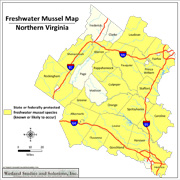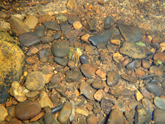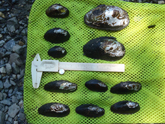 If you are planning to undertake a construction project that will impact or cross a perennial stream, you may need to survey for freshwater mussels as a condition of your wetland or waterway permit. Impacts could include altering the bottom or banks of streams where mussels are found, or potentially discharging sediment (due to land disturbance) into areas upstream of where mussels are found. Additionally, time of year restrictions on construction could be imposed if state or federally-protected mussels are present. Because new populations of protected mussels are being discovered regularly, conducting mussel surveys early in the development process can help avoid costly delays for upcoming projects. If you are planning to undertake a construction project that will impact or cross a perennial stream, you may need to survey for freshwater mussels as a condition of your wetland or waterway permit. Impacts could include altering the bottom or banks of streams where mussels are found, or potentially discharging sediment (due to land disturbance) into areas upstream of where mussels are found. Additionally, time of year restrictions on construction could be imposed if state or federally-protected mussels are present. Because new populations of protected mussels are being discovered regularly, conducting mussel surveys early in the development process can help avoid costly delays for upcoming projects.
Mussel surveys are typically conducted from April 1 to October 31. However, preliminary site evaluations to determine if suitable freshwater mussel habitat is present may be conducted any time of year; and for some sites, a land-based review may be all that is necessary to confirm absence of suitable habitat. If suitable habitat is present at a site, an in-stream assessment would be necessary to determine if state-protected mussel species are present. Because freshwater mussels retreat into the streambed during colder months, in-stream assessments are completed from April through October (depending on water temperatures). Additional time of year restrictions also may apply so as not to interfere with species-specific breeding and spawning periods.
Due to this limited survey "window", proper planning by project managers on sites having suitable habitat is critical. Failure to have a freshwater mussel survey conducted during the appropriate time period could potentially result in permit conditions that could affect or potentially delay project construction. Therefore, developers of sites within the species' range that will require wetlands permitting should also consider having a freshwater mussel habitat evaluation conducted as early in the process as possible to ensure the development schedule remains on track.
Mussel Species and Habitat
Several species of freshwater mussels, including dwarf wedgemussel (Alasmidonta heterodon), brook floater (Alasmidonta varicosa), Atlantic pigtoe (Fusconaia masoni), green floater (Lasmigona subviridis), and James spinymussel (Pleurobema collina) are considered rare in Virginia and are listed as "endangered" (dwarf wedgemussel, brook floater, and James spinymussel) or "threatened" (Atlantic pigtoe and green floater). (Click here to view a complete list of endangered or threatened mussel species.) As a result, they are protected by state endangered species laws, and the Virginia Department of Environmental Quality (DEQ) and Virginia Marine Resources Commission (VMRC) must consider potential impacts to these species before issuing permits to impact wetland and other jurisdictional waters. Note that the dwarf wedgemussel and James spinymussel are also federally "endangered" species. Thus, the U.S. Army Corps of Engineers (COE) must coordinate with the U.S Fish and Wildlife Service if this species could be impacted by a project that requires a COE permit.
 |
 |
 |
 |
 |
| Dwarf Wedgemussel |
Alasmidonta Varicosa |
Fusconaia Masoni |
Pleurobema collina |
L Subviridis |
According to the Biota of Virginia (BOVA) database managed by the Virginia Fish and Wildlife Information Service (VaFWIS) of the Virginia Department of Game and Inland Fisheries (DGIF), these mussel species have been documented within or could potentially inhabit a multitude of counties throughout Northern and Central Virginia, including Fairfax, Loudoun, Prince William, and Stafford. (Click here for a map detailing all Northern Virginia counties where endangered or threatened mussel species may be found.)
During permit coordination with the DEQ and VMRC, the DGIF generally requests that surveys be conducted in any stream within a 2-mile radius of previously recorded occurrences or likely occurrence if suitable habitat is present.
Freshwater Mussel Habitat and Characteristics
 As a whole, freshwater mussels are associated with un-polluted streams and ponds with stable substrates. Many species of freshwater mussels that inhabit streams that eventually lead into the Atlantic Ocean, also known as "Atlantic Slope" streams, will seek out riffle and run habitats composed of sand and small gravel. They are also found behind boulders and large woody debris piles that act as stabilizing structures and create flow refuges along stream banks. The dwarf wedgemussel, brook floater, Atlantic pigtoe, green floater, and James spinymussel are generally found in slow-moving creeks and rivers of varying-sizes, with stable substrates of sand and small gravel. None of these species are found in streams that frequently scour or have excessive sedimentation. Because these species are so susceptible to increased sediment loads, it is crucial that developers undertake adequate erosion control measures. As water temperatures decline in the fall and winter, they retreat into the warmer temperatures of the substrate and it is not uncommon for a mussel to bury itself 6 inches or even a foot into the streambed, making them nearly impossible to find during the winter months. As a whole, freshwater mussels are associated with un-polluted streams and ponds with stable substrates. Many species of freshwater mussels that inhabit streams that eventually lead into the Atlantic Ocean, also known as "Atlantic Slope" streams, will seek out riffle and run habitats composed of sand and small gravel. They are also found behind boulders and large woody debris piles that act as stabilizing structures and create flow refuges along stream banks. The dwarf wedgemussel, brook floater, Atlantic pigtoe, green floater, and James spinymussel are generally found in slow-moving creeks and rivers of varying-sizes, with stable substrates of sand and small gravel. None of these species are found in streams that frequently scour or have excessive sedimentation. Because these species are so susceptible to increased sediment loads, it is crucial that developers undertake adequate erosion control measures. As water temperatures decline in the fall and winter, they retreat into the warmer temperatures of the substrate and it is not uncommon for a mussel to bury itself 6 inches or even a foot into the streambed, making them nearly impossible to find during the winter months.
These species of freshwater mussels range in size from 1" to 3.5" in length. Shell shapes and sizes can vary dramatically depending on the local stream conditions where each individual mussel resides. Traumatic events during their early years, such as being pinched between rocks or stepped on by cattle, can cause dramatic changes to shell shape. Shell colors can range from hues of yellow, tan, green, and brown. In Piedmont and Coastal Plain streams, it is common for tannins in the water to stain shells dark brown or black. Wide variability in shell shape and color can cause these species to be easily confused for one another or for other commonly found species. Therefore, surveys for these species should only be conducted by experienced malacologists.
Conducting an ETS Survey
 WSSI has staff that bring a wealth of experience in habitat evaluations and freshwater mussel surveys throughout Virginia and southern Maryland. Additionally, WSSI holds Scientific Collection and Threatened and Endangered Species Collection permits from the DGIF and Maryland Department of Natural Resources, and has staff on the Approved Surveyor List for Virginia Atlantic Slope streams. This will allow WSSI to conduct surveys with in-house staff for federal, as well as state-threatened and endangered freshwater mussels. WSSI has staff that bring a wealth of experience in habitat evaluations and freshwater mussel surveys throughout Virginia and southern Maryland. Additionally, WSSI holds Scientific Collection and Threatened and Endangered Species Collection permits from the DGIF and Maryland Department of Natural Resources, and has staff on the Approved Surveyor List for Virginia Atlantic Slope streams. This will allow WSSI to conduct surveys with in-house staff for federal, as well as state-threatened and endangered freshwater mussels.
For further information about this topic, or to discuss how impacts to freshwater mussels may affect your upcoming projects, please contact Matt Johnson or Mark Headly.
|